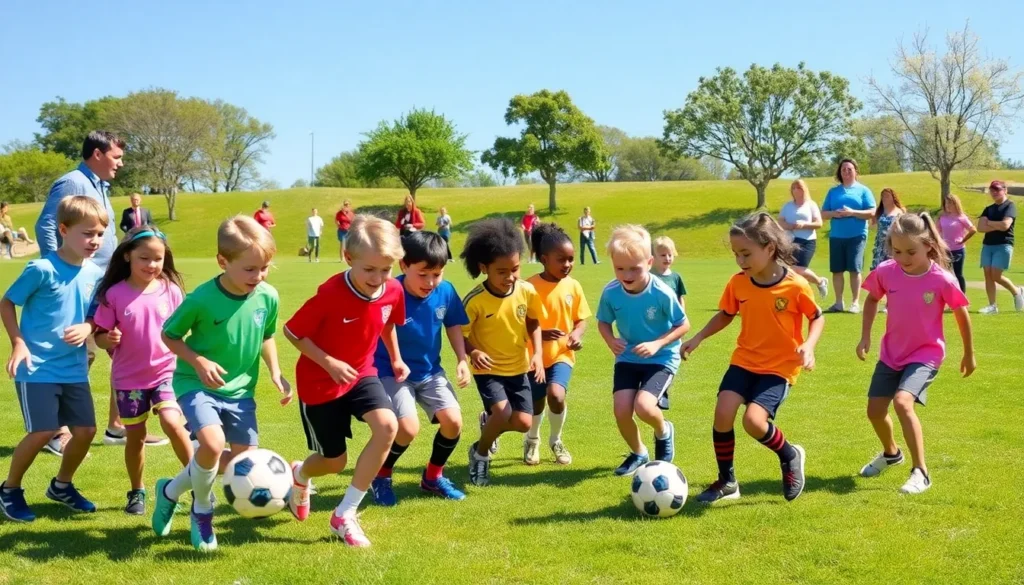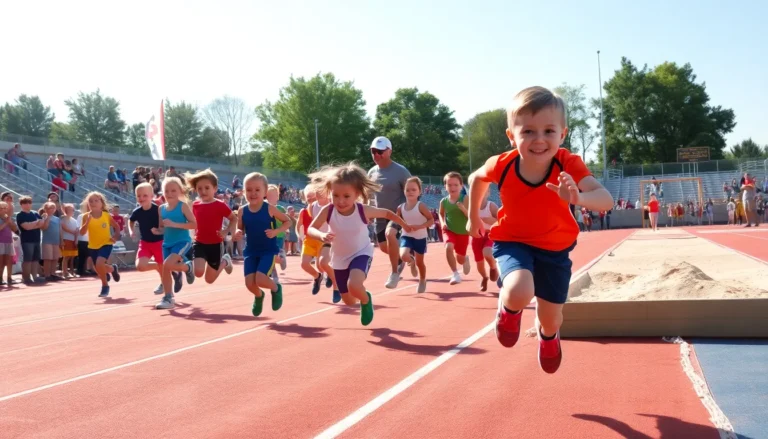Table of Contents
ToggleImagine a world where kids are running, laughing, and having the time of their lives. What’s the secret sauce? Sports games. Yes, those delightful adventures in teamwork and fun not only keep children active but also provide a treasure trove of benefits. From building friendships to boosting confidence, the world of sports is a fantastic playground for kids. So, strap in as we explore why sports games are essential for children’s development and how to make the most of them.
Benefits Of Sports Games For Children

Engaging in sports games provides a myriad of benefits for children, and it starts right from the playground. One of the most significant advantages is physical fitness. Running, jumping, and throwing help kids develop their motor skills. They burn energy like little machines, which is a great way to keep that sugar high in check.
Also, sports games introduce kids to teamwork and cooperation. They learn how to work together towards a common goal, which is a vital life skill. Communication becomes key, whether it’s about passing the ball or strategizing the next play. These interactions cultivate friendships that often last for years.
Also, participation in sports can boost a child’s self-esteem. When they score a goal or make a fantastic play, they feel accomplished. This sense of achievement fosters confidence that spills over into other areas of their life, such as academics and social situations.
Finally, let’s not forget about the fun factor. Sports games are an excellent way for kids to unwind, enjoy their time, and create memorable experiences. They’ll cherish these moments long after the final whistle blows.
Types Of Sports Games For Kids
When it comes to sports games for kids, the options are practically endless. Team sports often capture the spotlight, and classics like soccer, basketball, and baseball are always a hit. These games promote camaraderie and teach kids to support one another, fostering a sense of belonging.
On the other hand, individual sports like swimming, tennis, and gymnastics allow kids to shine on their own. They can develop personal skills and challenge themselves, which can be incredibly empowering. Also, there are less traditional sports, such as ultimate frisbee and floor hockey, that also provide fun and excitement while being inclusive and easy to pick up.
Besides, physical games such as tag or capture the flag can ignite children’s imagination. They require minimal equipment and can be played in various settings, from backyard gatherings to large gatherings at the park.
Eventually, the diversity of sports games means there’s something for every child, catering to their unique interests and abilities.
Team Sports vs. Individual Sports
The age-old debate between team sports and individual sports has perplexed parents and children alike. Each has its own set of advantages that contribute to a child’s growth. Team sports, such as soccer or football, emphasize collaboration. They teach kids how to share responsibility, strategize, and celebrate collective victories.
The joy of cheering for a teammate is infectious. This experience fosters lifelong friendships and creates a sense of community. That feeling of being part of a team tends to stick with them long after the game is over.
On the flip side, individual sports offer a different flavor. They empower kids to be self-reliant. In sports like swimming or martial arts, children learn to set personal goals and strive toward them. They get to experience the thrill of personal accomplishment, and they can train at their own pace, which can be invigorating.
So, whether your child thrives in a team setting or prefers to go solo, both paths can lead to personal growth and joy. Often, it’s a combination of both that helps create a well-rounded athlete.
How To Choose The Right Sports Game
Choosing the right sports game for a child can feel like a challenging job for many parents. The first step is to consider the child’s interests and personality. Does she crave teamwork, or does he prefer solo challenges?
Next, think about the child’s age and physical ability. Some sports are more suitable for younger kids, while others might be a better fit for older, more developed players. Also, try out a variety of sports. A child might discover hidden talents in an unexpected area after trying different games. Emphasizing fun over competition is crucial, especially in the early stages. After all, the goal is to cultivate a love for physical activity, not instill a fear of failure.
Finally, involve the child in the decision-making process. This engagement allows them to feel a sense of ownership and excitement about their choice. When they feel invested, they are more likely to commit and enjoy the experience.
Tips For Organizing Sports Games
Planning a sports game can be a thrilling try with the right approach. Start by selecting a suitable location, park, school field, or backyard, ensuring it’s safe and accessible. Guests might flock to a local park with ample space.
Next, gather the necessary equipment, which might range from balls to cones, ensuring everyone is well-prepared. Dividing kids into teams can be an art in itself. Aim for balanced teams to foster competitive spirit and reduce frustration.
Also, consider having adults or older teens help or referee the game. Having someone to ensure fair play and encourage good sportsmanship really goes a long way in making the experience enjoyable.
Finally, don’t forget the post-game celebration. A quick snack or a simple acknowledgment of the efforts can elevate the joy of the game. Celebrating everyone’s participation matters, reinforcing the message that it’s not just about winning, but having fun.
Safety Considerations For Kids Playing Sports
Safety is paramount when it comes to children playing sports. First and foremost, ensure that kids are equipped with the proper gear. Helmets, shin guards, and supportive shoes help protect young bodies as they take on various activities.
Supervision is another critical element. An adult’s watchful eye can catch potential hazards and provide support, while also helping establish rules for safe play. Encourage children to stay hydrated, especially during hot days, since they might forget in the excitement of the game.
It’s also essential to set age-appropriate games. Older kids might be ready for a little more competitiveness, while younger ones thrive in a more forgiving environment. Teaching them the importance of listening to their bodies is crucial, even when they feel invincible. Caution helps prevent injuries and allows them to enjoy sports for years to come.








